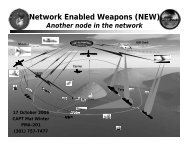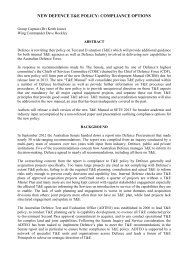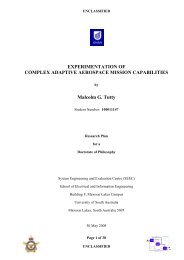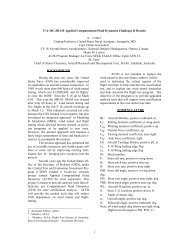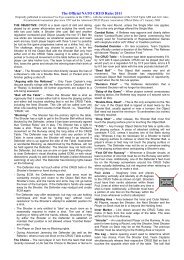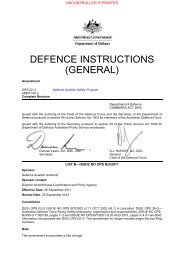MIL-HDBK-244A 6 apr 90.pdf
MIL-HDBK-244A 6 apr 90.pdf
MIL-HDBK-244A 6 apr 90.pdf
Create successful ePaper yourself
Turn your PDF publications into a flip-book with our unique Google optimized e-Paper software.
<strong>MIL</strong>-<strong>HDBK</strong>-<strong>244A</strong><br />
1. SCOPE<br />
1 .1 m. The handbook is intended to cover all<br />
aspects of aircraft/weaponscompatibility: mechanical, electrical, structural,<br />
aerodynamic, etc. Theseare dealt with individuallyas they relate to<br />
various elements of the complete system. The material has been organized to<br />
present design guidelines for the five general categories of weapon system<br />
components: aircraft, suspension equipment, stores, stores management<br />
equipment, and ground support equipment. This informationdeals with<br />
compatibility of the components while the system is on the ground, in flight,<br />
and during weapon delivery.<br />
1.2 Successful airborne wea~on svstem. A successful airborne<br />
weapon system is achieved by proper matching of all components. Integrating<br />
the numerous components which make up a complete weapon system into one effective,<br />
efficient, maintainable, and reliable operating unit will not produce<br />
the desired compatibility unless each element is designed with proper<br />
considerationof its relation to all other elements. The complexity of modern<br />
airborne weapon systems and the interdependencybetween components make<br />
the task of assuring compatibility difficult. Therefore, definitive guidelines<br />
are needed to provide engineering direction forthe development of all<br />
components. Because some major components are used in more than one weapon<br />
system, there must be consistency, versatility and clarity in the guidelines<br />
prepared for this:purpose. This handbook deals in detail with all individual<br />
elements to present guidelines for the design integrationof totally compatible<br />
systems.<br />
1.3 Detailed enaineerina data. This handbook does not include<br />
detailed engineering data necessary to design specific components of a compatible<br />
system. Much of the published material useful in the design process<br />
is available through government technical information services. However,<br />
there are large quantities of additional technical data and design informs-<br />
-tionlocated at various government laboratoriesand contractor facilities.<br />
““”Thereis no intent to include that material here because of the large volume<br />
of data involved. Direct contact with the responsible organizations may be<br />
necessary if the design information is needed to apply the compatibility<br />
guidelines presented in this handbook.<br />
1<br />
Source: http://www.assistdocs.com -- Downloaded: 2009-07-16T13:55Z<br />
Check the source to verify that this is the current version before use.





